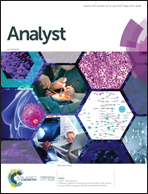Dispersive micro-solid phase extraction based on Fe3O4@SiO2@Ti-MOF as a magnetic nanocomposite sorbent for the trace analysis of caffeic acid in the medical extracts of plants and water samples prior to HPLC-UV analysis†
Abstract
In the present work, a simple and rapid method, namely magnetic dispersive micro-solid phase extraction (MD-μ-SPE), was developed using magnetic Fe3O4@SiO2@Ti-MOF (metal–organic framework)-nanocomposites (NCs) as a viable and efficient sorbent to pre-concentrate and assess caffeic acid (CA) in the medical extracts of plants and water samples. The Fe3O4@SiO2@Ti-MOF-NCs were characterized by various techniques, including FESEM, EDX, FTIR, BET, XRD and VSM. Following the extraction process, HPLC was employed to quantify CA. The effects of different parameters on the MD-μ-SPE method were fully investigated by the Plackett–Burman (PBD) and central composite design (CCD). The highest extraction percentage (99.76%) was obtained under different conditions: pH 4.8, 9 mg of Fe3O4@SiO2@Ti-MOF-NCs, sonication for 5 min, and an eluent solvent of 240 μL. Under optimum conditions, the limits of detection (LODs) and the limits of quantitation (LOQs) were obtained in the range of 0.016–0.021 ng mL−1 and 0.052–0.068 ng mL−1, respectively. The reproducibility and repeatability (RSDs, n = 5) were in the range of 3.65–8.66% and 1.84–5.54%, respectively. Overall, the proposed method was successfully used to determine CA in the medical extracts of plants and water samples with favorable recoveries.



 Please wait while we load your content...
Please wait while we load your content...